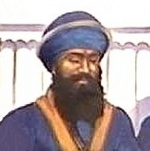Template:AOW332: Difference between revisions
Hari singh (talk | contribs) No edit summary |
Hari singh (talk | contribs) No edit summary |
||
| Line 2: | Line 2: | ||
{{pm|File:Dharm Singh of the panj pyare.jpg|[[Bhai Dharam Singh]] one of the [[Panj Pyare]]}} | {{pm|File:Dharm Singh of the panj pyare.jpg|[[Bhai Dharam Singh]] one of the [[Panj Pyare]]}} | ||
'''Bhai Dharam Singh''' ([[3 November]] [[1666]] - [[1708]]), one of the [[Panj Piare]] or the Five Beloved, the forerunners of [[Khalsa]] and was a farmer by profession. He was the son of Bhai Sant Ram and Mai Sabho, of Hastinapur, an ancient town on the right bank of the [[Wikipedia:Ganges|Ganges]], 35 km northeast of Meerut (29°N, 77° 45'E). | '''[[Bhai Dharam Singh]]''' ([[3 November]] [[1666]] - [[1708]]), one of the [[Panj Piare]] or the Five Beloved, the forerunners of [[Khalsa]] and was a farmer by profession. He was the son of Bhai Sant Ram and Mai Sabho, of Hastinapur, an ancient town on the right bank of the [[Wikipedia:Ganges|Ganges]], 35 km northeast of Meerut (29°N, 77° 45'E). | ||
Dharam Das, as he was originally named, was born around 1666. As a young man, he fell into the company of a [[Sikh]] who introduced him to the teachings of the [[Guru]]s. He left home at the age of thirty in quest of further instruction. At the Sikh shrine of Nanak Piau, dedicated to [[Guru Nanak]], he was advised to go to [[Guru Gobind Singh]] at [[Anandpur]], where he arrived in 1698. | Dharam Das, as he was originally named, was born around [[1666]]. As a young man, he fell into the company of a [[Sikh]] who introduced him to the teachings of the [[Guru]]s. He left home at the age of thirty in quest of further instruction. At the Sikh shrine of Nanak Piau, dedicated to [[Guru Nanak]], he was advised to go to [[Guru Gobind Singh]] at [[Anandpur]], where he arrived in 1698. | ||
A few months later came the historic [[Baisakhi]] gathering of [[1699]] at which five Sikhs responding to five successive calls of [[Guru Gobind Singh]]. One after the other, they offered to lay down their heads. The Guru blessed them and called them [[Panj Piare]], the five beloved ones. <!--- They were anointed as the first five members of the brotherhood of the [[Khalsa]] inaugurated on that day. [[Guru Gobind Singh]] then begged them to administer to him the vows of initiation.----> {{aowf|Bhai Dharam Singh}} | A few months later came the historic [[Baisakhi]] gathering of [[1699]] at which five Sikhs responding to five successive calls of [[Guru Gobind Singh]]. One after the other, they offered to lay down their heads. The Guru blessed them and called them [[Panj Piare]], the five beloved ones. <!--- They were anointed as the first five members of the brotherhood of the [[Khalsa]] inaugurated on that day. [[Guru Gobind Singh]] then begged them to administer to him the vows of initiation.----> {{aowf|Bhai Dharam Singh}} | ||
Revision as of 19:40, 2 November 2011

Bhai Dharam Singh (3 November 1666 - 1708), one of the Panj Piare or the Five Beloved, the forerunners of Khalsa and was a farmer by profession. He was the son of Bhai Sant Ram and Mai Sabho, of Hastinapur, an ancient town on the right bank of the Ganges, 35 km northeast of Meerut (29°N, 77° 45'E).
Dharam Das, as he was originally named, was born around 1666. As a young man, he fell into the company of a Sikh who introduced him to the teachings of the Gurus. He left home at the age of thirty in quest of further instruction. At the Sikh shrine of Nanak Piau, dedicated to Guru Nanak, he was advised to go to Guru Gobind Singh at Anandpur, where he arrived in 1698.
A few months later came the historic Baisakhi gathering of 1699 at which five Sikhs responding to five successive calls of Guru Gobind Singh. One after the other, they offered to lay down their heads. The Guru blessed them and called them Panj Piare, the five beloved ones. .....More
